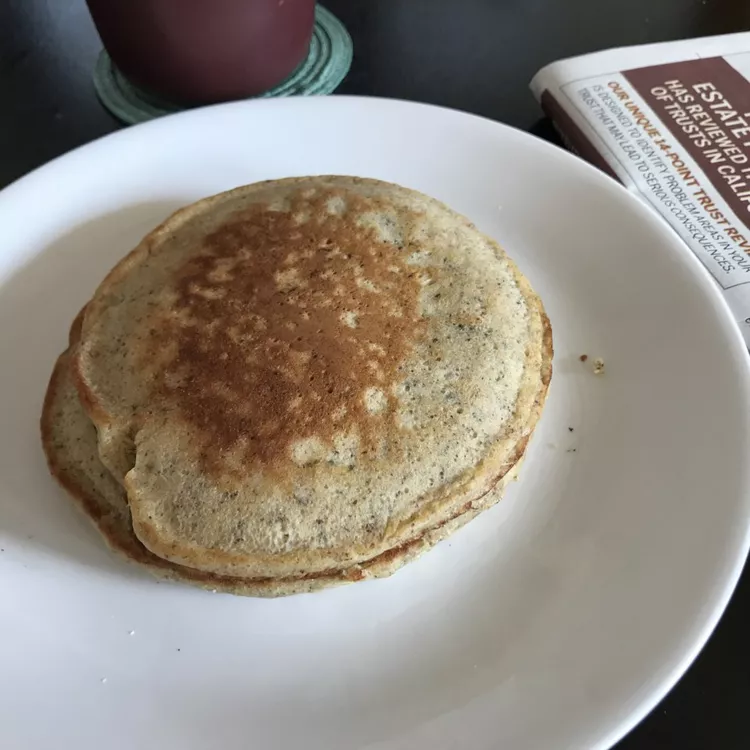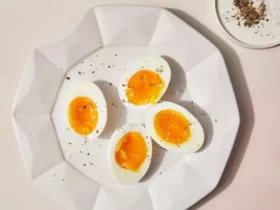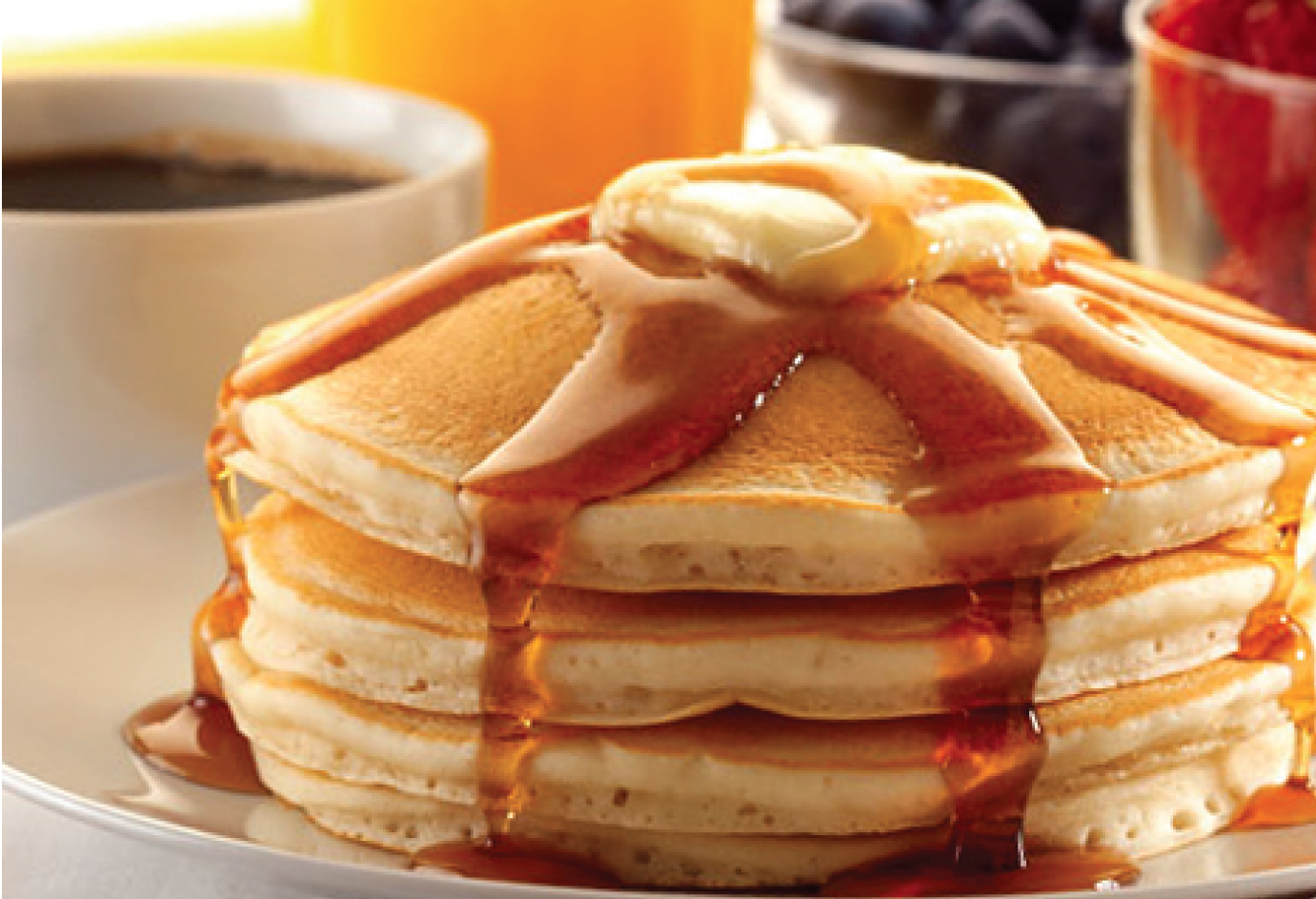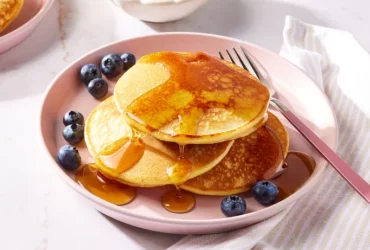Ingredients
Main Ingredients
The main ingredients for these easy high-fiber pancakes are:
- All-purpose flour: Provides structure and texture to the pancakes.
- Whole wheat flour: Adds fiber, nutrients, and a nutty flavor to the pancakes.
- Oat bran: High in soluble fiber and contributes to the overall high-fiber content of the pancakes.
- Brown sugar: Adds sweetness without refined sugars.
- Unsweetened applesauce: Replaces some of the oil or butter and adds moisture.
- Egg: Provides protein, structure, and richness to the pancakes.
- Baking powder: Leavening agent that helps pancakes rise.
- Salt: Balances flavors.
- Buttermilk: Adds acidity, tenderness, and flavor.
- Vegetable oil or melted butter: Adds moisture and richness to the pancakes.
Optional ingredients include:
- Nuts or seeds for added crunch and nutrition
- Cinnamon, nutmeg, or other spices for extra flavor
- Other fruits like blueberries, bananas, or raspberries for added taste and nutrients
Please note that you can adjust the proportions of the ingredients to suit your dietary needs and preferences.
The key to making high-fiber pancakes lies in selecting the right ingredients. When it comes to incorporating fiber-rich elements into our recipes, we need to focus on using whole grains, fruits, and vegetables that are packed with dietary fiber.
Whole grain flours, such as oat flour, wheat germ, or bran, are excellent sources of dietary fiber. Oat flour, in particular, is a popular choice for baked goods because it contains both soluble and insoluble fiber, which helps promote digestive health and satiety.
Certain fruits, like apples and berries, are high in fiber and can be used as added ingredients or pureed into the batter to enhance the flavor and nutritional profile of our pancakes. Apples contain a type of fiber called pectin, which is a natural gelling agent that helps hold the ingredients together and adds structure to the pancake.
Other fruits like bananas and avocados can be used as binding agents due to their high starch content. When ripe, these fruits have an even higher concentration of starch, making them ideal for adding moisture, texture, and fiber-rich goodness to our pancakes.
Mixing these whole grain flours with other ingredients such as almond flour or coconut flour helps create a balanced nutritional profile in our high-fiber pancakes. Almond flour is rich in healthy fats and protein, while coconut flour provides additional fiber content and can help absorb excess moisture in the batter.
Another crucial ingredient to consider when making high-fiber pancakes is spices and herbs, such as cinnamon or ginger. Not only do these spices add flavor but they also possess antioxidant properties that may help boost overall health.
In addition, eggs are a versatile binding agent used in many pancake recipes due to their high protein content. While whole eggs offer several benefits, using egg whites alone can reduce the saturated fat and cholesterol content of our pancakes while maintaining essential nutrients like vitamins B12 and B6.
Lastly, we have milk alternatives or dairy-based products that contain various levels of lactose-free carbohydrates, which contribute to the overall calorie and nutrient profile of our high-fiber pancakes. Using unsweetened almond milk as a substitute for regular milk adds fewer calories but still supplies beneficial minerals like calcium, magnesium, and potassium.
With these ingredients combined in moderation, we can craft delicious and nutritious high-fiber pancakes that provide long-lasting energy and essential vitamins, minerals, and macronutrients to fuel our bodies effectively.
Oats (1 cup)
Oats are a key ingredient in this Easy High-Fiber Pancakes recipe, and they’re an excellent source of fiber, protein, and various essential nutrients.
A single cup of oats contains:
- Fiber: approximately 10-12 grams
- Protein: around 6-7 grams
- Magnesium: a significant amount, about 20-25% of the daily recommended intake
- Copper: a moderate amount, approximately 10-15% of the daily recommended intake
- Iron: some iron content, although not as high as other ingredients in the recipe
Oats are also relatively low on the glycemic index (GI) scale, which means they’re less likely to cause a spike in blood sugar levels. This makes them an excellent choice for those looking to manage their blood sugar and maintain stable energy levels.
In addition to their nutritional benefits, oats are incredibly versatile and can be used in a variety of ways, from baked goods to soups and stews. When it comes to this Easy High-Fiber Pancakes Recipe, the oats will help bind all the ingredients together, create a fluffy texture, and provide sustained energy throughout the day.
To make the most of your 1 cup of oats in this recipe, be sure to choose rolled or steel-cut oats. These types of oats have not been highly processed, which helps preserve their natural nutrients and fiber content.
Banana (mashed, 1)
- Mashed banana is one of the key ingredients used in this recipe for easy high-fiber pancakes.
- The banana should be ripe but not overly soft, as it will be mashed and added to the batter.
- Ripened bananas are sweeter and softer, making them ideal for mashing and incorporating into baked goods.
- To mash a banana, peel it first and then place it in a mixing bowl. You can use a fork to mash it until it reaches your desired consistency.
- Aim for a texture that is still slightly chunky, rather than smooth, as this will provide a nice contrast in the finished pancakes.
- One mashed banana is used per recipe, and you can adjust the amount of sugar or other sweeteners to taste if needed.
- Mashed bananas add natural sweetness and moisture to these high-fiber pancakes, making them a delicious breakfast option for those with dietary restrictions or preferences.
Eggs (2 large)
- Eggs are a crucial ingredient in many baked goods and cooked dishes, including our easy high-fiber pancakes recipe.
- For this specific recipe, we require 2 large eggs.
The nutritional value of eggs makes them an excellent addition to our high-fiber pancakes. A large egg contains:
- Protein: Eggs are a rich source of protein, essential for muscle growth and maintenance in the body. Each large egg provides about 6-7 grams of protein.
- Vitamins and minerals: Eggs are an excellent source of various vitamins and minerals such as vitamin D, B12, and iron. These nutrients play a crucial role in maintaining healthy red blood cells, nerve function, and immune system function.
- Healthy fats: While eggs are relatively low in calories, they contain a small amount of healthy fats, which support heart health and provide sustained energy.
When selecting eggs for this recipe, ensure that you choose large eggs with clean and intact shells. Fresh eggs will help to create the perfect texture and flavor in your high-fiber pancakes.
In our easy high-fiber pancakes recipe, the eggs serve as a binding agent, holding the various ingredients together while maintaining their moisture content. The eggs also contribute to the richness and creaminess of the final product.
Flaxseed (ground, 2 tbsp)
Flaxseed is a nutrient-rich ingredient that plays a crucial role in adding fiber, protein, and omega-3 fatty acids to various recipes, including our easy high-fiber pancakes recipe.
The main ingredient we’ll be focusing on today is ground flaxseed, which can be obtained by grinding whole flaxseeds into a fine powder using a spice grinder or coffee mill. Ground flaxseed is an ideal addition to baked goods due to its finer texture and increased bioavailability of nutrients compared to whole flaxseeds.
For this recipe, we recommend using 2 tablespoons of ground flaxseed as it provides the perfect balance of fiber, protein, and omega-3 fatty acids without overpowering the other ingredients. If you’re new to working with flaxseed, start by substituting a small amount (about 1 teaspoon) in your pancake batter and adjust according to taste and texture preferences.
The nutritional benefits of ground flaxseed include:
- Fiber content: Ground flaxseed contains both soluble and insoluble fiber, which can help promote digestive health, prevent constipation, and support healthy blood sugar levels.
- Protein content: Flaxseed is a rich source of plant-based protein (approximately 3-4 grams per tablespoon), making it an excellent option for vegans and vegetarians seeking to boost their protein intake.
- Omega-3 fatty acid content: Ground flaxseed is an abundant source of alpha-linolenic acid (ALA), a type of omega-3 fatty acid that has been linked to various health benefits, including reduced inflammation and improved heart health.
Incorporating ground flaxseed into our high-fiber pancakes recipe not only adds nutritional value but also enhances the texture and flavor of the pancakes. The subtle nutty taste and crunchy texture provided by the ground flaxseed complement the sweetness of the other ingredients, resulting in a delicious and satisfying breakfast treat.
When using ground flaxseed in baking, it’s essential to note that it can absorb liquid content differently than traditional flour. To avoid any issues with texture or consistency, be sure to adjust the liquid content according to your desired pancake thickness and batter viscosity.
In summary, ground flaxseed is a nutritious addition to our easy high-fiber pancakes recipe, providing an impressive amount of fiber, protein, and omega-3 fatty acids. By incorporating this superfood into your breakfast routine, you’ll not only boost your nutritional intake but also indulge in a delicious and satisfying treat that’s perfect for any time of day!
The success of our delicious and easy high-fiber pancakes recipe greatly depends on the selection of ingredients.
Here are some key ingredients we recommend:
- Oat flour
- Banana, mashed
- Eggs
- Sugar
- Flaxseed meal (ground)
- Honey or maple syrup (optional)
- Cinnamon (optional)
- Milk (dairy or non-dairy, such as almond milk)
Other ingredients you can include in your pancakes to increase the fiber content are:
- Fresh fruit (such as blueberries, strawberries, or raspberries)
- Nuts or seeds (such as walnuts, almonds, chia seeds, or hemp seeds)
Instructions
Preparation
To prepare for making easy high-fiber pancakes, it’s essential to have all the necessary ingredients and equipment ready.
Ingredients
- 1 cup rolled oats
- 1/2 cup whole wheat flour
- 1/4 cup sugar
- 2 teaspoons baking powder
- 1/4 teaspoon salt
- 1 large egg
- 1 cup low-fat milk
- 1 tablespoon honey or maple syrup (optional)
- Chopped nuts, seeds, or fruit (optional)
Equipment
- A medium bowl for whisking dry ingredients
- A separate large bowl for mixing wet ingredients and combining with dry ingredients
- A non-stick pan or griddle for cooking pancakes
- Spoons, a spatula, and measuring cups as needed
Before beginning to make the batter, preheat a non-stick pan or griddle over medium heat. This ensures that your pancakes will cook evenly.
The dry ingredients should be whisked together in one bowl before moving on to combine them with wet ingredients. This ensures all ingredients are well-mixed and prevents lumps from forming.
Instructions for executing any task are essential to ensure that the desired outcome is achieved effectively and efficiently.
The following are the key elements of instructions:
- Clear and concise language: Instructions should be written in a way that is easy to understand, avoiding ambiguity and complexity.
- Specificity: Each step or action must be clearly outlined with no room for confusion.
- Order of steps: The order of the instructions must make sense, allowing the person executing them to follow logically and smoothly from one step to the next.
- Error prevention and correction: Instructions should anticipate potential errors and provide solutions or corrections for each step. This includes what could go wrong and how it can be fixed.
- Timing: If time-sensitive, the instructions must specify the time allowed to complete a task and any deadlines that need to be met.
- Visual aids: Including diagrams or pictures where necessary for complex tasks helps in understanding and following instructions more effectively.
In the context of the Easy High-Fiber Pancakes Recipe, clear and concise language is crucial as it ensures that each step, from preparing ingredients to cooking the pancakes, is executed correctly. Specificity in the recipe prevents mistakes in measurement or preparation. The order of steps allows for efficient use of time and resources, preventing confusion and wasted effort.
For example, when a recipe states “Combine 2 cups of rolled oats, 1/2 cup of almond flour, 1/4 teaspoon of salt, and 1 tablespoon of honey in a large bowl”, it is specific about the ingredients needed. It also anticipates that you might have questions, like what type of flour to use or how to measure accurately.
Following these guidelines for instructions not only improves compliance but also enhances quality of work by ensuring every step is executed as intended, leading to better results in any task.
In a large bowl, whisk together oats, mashed banana, eggs, and ground flaxseed.
To prepare the high-fiber pancake batter, it’s crucial to follow a set of instructions that ensure the end result is not only delicious but also packed with nutrients.
One of the key ingredients in this recipe is Oats. As you begin, combine 1 cup of rolled oats with 2 mashed bananas, which serve as a natural sweetener and add moisture to the batter. Make sure to mash the bananas thoroughly before adding them to avoid any texture issues.
Next, crack 2 large eggs into the bowl and whisk them together with the oats and banana mixture until well combined. Eggs provide not only flavor but also richness and help bind the ingredients together.
The addition of Ground Flaxseed is essential for its high fiber content and nutty flavor. Mix 1 tablespoon of ground flaxseed into the batter and whisk until smooth. The ground flaxseed absorbs some of the liquid from the eggs, creating a gel-like texture that helps thicken the batter.
Continue to whisk all the ingredients together in the large bowl until they form a smooth and well-mixed batter. Be sure to scrape down the sides of the bowl with a rubber spatula as needed to ensure everything is fully incorporated.
This high-fiber pancake batter can be refrigerated for up to 24 hours, allowing you to prepare it ahead of time and have a healthy breakfast ready whenever you need it.
Add water as needed to achieve the desired consistency. The batter should still be slightly thick.
To ensure that your high-fiber pancakes turn out perfectly, it’s essential to follow a few key instructions.
Step 1: Prepare the Dry Ingredients
Mix together in a large bowl:
- 1 and 3/4 cups all-purpose flour
- 2 tablespoons sugar
- 5 teaspoons baking powder
- 1 teaspoon salt
- 1 tablespoon chia seeds (optional)
- 1/4 cup ground flaxseed (optional)
Mix the dry ingredients until they are well combined.
Step 2: Prepare the Wet Ingredients
In a separate bowl, whisk together:
- 1 large egg
- 1/4 cup unsweetened almond milk (or milk of your choice)
- 2 tablespoons melted coconut oil (or other healthy oil)
- 2 teaspoons vanilla extract
Whisk the wet ingredients until they are smooth and well combined.
Step 3: Combine the Wet and Dry Ingredients
- Add the wet ingredients to the dry ingredients and mix until just combined. The batter should still be slightly lumpy.
- If you’re using ground flaxseed, mix it in according to package instructions (usually by letting it sit for a few minutes before mixing).
Step 4: Add Water as Needed
Add water as needed to achieve the desired consistency. The batter should still be slightly thick.
You can test the consistency of the batter by dropping a small amount onto a non-stick skillet or griddle. If it forms a nice, round pancake and cooks evenly, you’re good to go!
Instructions play a vital role in guiding individuals through complex tasks or recipes, providing them with clear and concise directions to achieve a desired outcome.
In the context of an easy high-fiber pancakes recipe, instructions are essential for ensuring that consumers create a dish that is both nutritious and delicious.
A typical set of instructions for this recipe might begin by listing the necessary ingredients, including rolled oats, almond milk, eggs, honey, vanilla extract, baking powder, salt, chia seeds, and flaxseeds, to name a few.
These ingredients would then be grouped together into clear categories, such as dry ingredients, wet ingredients, and mix-ins, allowing users to easily locate the items they need.
The instructions would likely proceed with detailed step-by-step directions for preparing the ingredients, combining them in a specific order, and mixing the batter until smooth and well combined.
This might involve whisking the dry ingredients together, whisking the wet ingredients separately, then slowly pouring the wet mixture into the dry ingredients while continuing to whisk until just combined.
Users would also be instructed on how to add any desired mix-ins, such as nuts or fruit, and fold them gently into the batter to avoid overmixing.
The instructions might also cover essential tips for cooking pancakes, including using a non-stick pan or griddle, heating it to the right temperature, pouring the right amount of batter onto the pan, and adjusting the heat as needed to prevent burning.
Finally, the instructions would likely provide guidance on how to serve and enjoy the pancakes, such as topping them with fresh fruit, maple syrup, or a dollop of whipped cream.
In total, clear and effective instructions are crucial in helping consumers create delicious and nutritious high-fiber pancakes that meet their dietary needs and preferences.
Nutrition Benefits
Fiber Content
Fiber is an essential nutrient that plays a crucial role in maintaining good health. It is found primarily in plant-based foods and serves as a vital component for proper digestion, satiety, and overall well-being.
When it comes to incorporating more fiber into your diet, breakfast options like high-fiber pancakes are excellent choices. These delicious treats offer numerous benefits, starting with the ability to regulate blood sugar levels. Fiber helps slow down the absorption of sugar by the body, which in turn prevents a sudden spike in glucose levels.
High-fiber pancakes also contribute significantly to weight management. By keeping you fuller for longer, fiber reduces the likelihood of overeating and aids in achieving your weight loss goals more efficiently. Moreover, it boosts metabolism, further facilitating fat burning throughout the day.
The benefits of high-fiber pancakes extend beyond physical health; they also impact mental well-being. Consuming adequate amounts of fiber has been shown to reduce symptoms of anxiety and depression by promoting healthy gut bacteria, which plays a crucial role in producing neurotransmitters that regulate mood.
Focusing on the fiber content of these pancakes, it’s essential to note that not all high-fiber ingredients are created equal. Whole wheat flour, for instance, contains both soluble and insoluble fiber, whereas others like oats and flaxseed primarily offer the soluble type. A balanced mix of both is ideal.
To make your own high-fiber pancakes at home, a simple recipe involves combining 1 cup whole wheat flour, 2 tablespoons rolled oats, 1 tablespoon flaxseeds, and 1/4 teaspoon salt. Add in some liquid ingredients such as eggs, milk, or yogurt, and then top with fresh fruit for added flavor.
High-fiber foods have been touted for their numerous health benefits, and incorporating them into our diets can lead to improved digestion, satiety, and overall well-being.
Nutrition Benefits of High Fiber Foods
Blood Sugar Control
High fiber foods can help regulate blood sugar levels by slowing the absorption of glucose into the bloodstream. This is particularly beneficial for individuals with diabetes or those at risk of developing insulin resistance.
Heart Health
Fiber has been shown to lower total cholesterol and LDL (“bad”) cholesterol levels, reducing the risk of heart disease, high blood pressure, and stroke.
Cancer Prevention
A diet rich in fiber has been linked to a reduced risk of colorectal cancer, as well as other types of cancer such as breast, prostate, and lung cancer.
Weight Management
High fiber foods tend to be more filling, which can lead to weight loss and improved weight management. Additionally, fiber-rich diets have been shown to increase satiety and reduce hunger.
Digestive Health
Fiber acts as a prebiotic, feeding the good bacteria in the gut, promoting a healthy gut microbiome and supporting regular bowel movements.
Improved Nutrient Absorption
High fiber foods can improve the absorption of essential nutrients like vitamins and minerals, helping to ensure that your body is getting all the nutrients it needs to function optimally.
Incorporating high-fiber foods into your diet can have numerous benefits for overall health and well-being. By making simple changes to your diet, such as increasing your intake of fruits, vegetables, whole grains, and legumes, you can reap the rewards of a fiber-rich lifestyle.
This recipe provides approximately 10 grams of fiber per serving.
- The recipe for high-fiber pancakes offers a nutritious and delicious breakfast option, rich in dietary fiber content.
- Fiber plays a crucial role in maintaining digestive health by promoting regular bowel movements, preventing constipation, and supporting healthy blood sugar levels.
- In addition to its digestive benefits, consuming adequate fiber also supports the maintenance of a healthy weight by contributing to feelings of fullness and satisfaction.
- Furthermore, high-fiber diets have been associated with reduced risks for chronic diseases such as heart disease, type 2 diabetes, and certain cancers.
- The inclusion of various fruits, nuts, seeds, and whole grains in the recipe contributes significantly to its fiber content. The combination of ingredients ensures a balanced nutritional profile that supports overall well-being.
Daily Fiber Recommendations
- Women aged 18-50 years: 25 grams per day
- Men aged 18-50 years: 30 grams per day
- Women over 50 years and men over 70 years: 20-22 grams per day
This recipe provides an excellent opportunity to increase daily fiber intake while enjoying a tasty and satisfying meal.
Nutrient Breakdown of High-Fiber Pancakes Recipe
- Fiber: 10 grams per serving (approximately)
- Protein: 4-5 grams per serving (dependent on milk and egg choice)
- Healthy fats: from nuts, seeds, and whole grains
- Vitamins and minerals: from fruits, nuts, seeds, and whole grains
This nutrient-dense recipe supports overall nutritional well-being by providing a balanced mix of carbohydrates, protein, and healthy fats.
According to the American Heart Association, consuming 2530 grams of dietary fiber a day can help lower cholesterol levels and reduce the risk of heart disease.
A high-fiber diet has numerous benefits, particularly for the cardiovascular system. According to the American Heart Association, consuming 25-30 grams of dietary fiber per day can help lower cholesterol levels and reduce the risk of heart disease.
Dietary fiber comes in two forms: soluble and insoluble. Soluble fiber dissolves in water and can help lower cholesterol levels by binding to bile acids and removing them from the body, which in turn reduces the amount of cholesterol produced by the liver. Some examples of soluble fiber-rich foods include oats, barley, nuts, seeds, and fruits like apples and berries.
On the other hand, insoluble fiber does not dissolve in water and can help promote regular bowel movements and prevent constipation. Foods rich in insoluble fiber include whole grains, wheat bran, vegetables like carrots and broccoli, and legumes such as beans and lentils.
Eating a high-fiber diet has several additional benefits beyond its impact on heart health. It can also help with weight management by keeping you feeling fuller for longer, reducing the risk of developing type 2 diabetes, and promoting healthy blood sugar levels.
Here are some tips to incorporate more fiber into your diet:
- Incorporate high-fiber foods into your meals, such as adding beans or lentils to soups and stews
- Choose whole grains over refined grains for breakfast cereals, breads, and pasta
- Snack on fruits and vegetables instead of processed snacks
- Try to include a variety of different colored vegetables in your meals to ensure you’re getting a range of different nutrients
In the context of this easy high-fiber pancakes recipe, we can see how incorporating more fiber into our diet can be delicious and convenient. By using whole wheat flour and adding fiber-rich ingredients like chia seeds or flaxseeds to our pancake batter, we can increase the nutritional value of our breakfast while also satisfying our sweet tooth.
- Nutrition benefits play a significant role in understanding why high-fiber pancakes are recommended as part of a healthy diet.
- High fiber content in food helps to regulate bowel movements, manage blood sugar levels and support weight management.
- The American Heart Association recommends that adults consume at least 25-30 grams of dietary fiber daily for optimal health benefits.
- A high-fiber diet has been linked to a reduced risk of heart disease, type 2 diabetes, and certain types of cancer, such as colorectal cancer.
- Additionally, adequate fiber intake can also help to lower cholesterol levels and improve overall gut health.
- The inclusion of ingredients like whole wheat flour, oats, or bran in high-fiber pancake recipes provides a boost to daily fiber consumption.
- Furthermore, incorporating fruits, nuts, or seeds into the batter can enhance the nutritional benefits, providing essential vitamins, minerals, and antioxidants.
- Adequate hydration is also crucial when consuming high-fiber foods like pancakes to help with digestion and prevent potential side effects like bloating or gas.
- By choosing nutrient-dense ingredients and emphasizing whole grains over refined flour, individuals can reap the rewards of a healthy high-fiber diet that supports optimal nutrition benefits.
- The easy high-fiber pancake recipe provided is an excellent example of how to incorporate nutritious ingredients into everyday meals while enjoying the convenience and taste of traditional pancakes.
- Best Dun & Bradstreet (DNB) Alternatives for 2025 - April 24, 2025
- Best Seamless.ai Alternatives for 2025 - April 22, 2025
- Best Coldlytics Alternatives for 2025 - April 22, 2025














